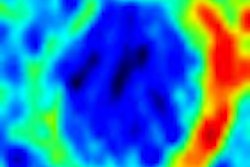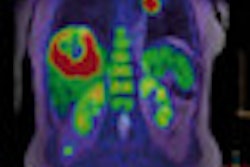Quantitative MR measures such as diffusion-weighted imaging (DWI) and dynamic contrast-enhanced (DCE) imaging show potential for predicting breast cancer prognosis and treatment planning, according to research presented on Wednesday at the San Antonio Breast Cancer Symposium.
Dr. Sana Parsian, from the University of Washington, and colleagues conducted a study based on the hypothesis that DWI and DCE data would correlate with breast cancer histopathological markers and allow a tumor's cellularity and vascularity to be measured.
In DWI, the diffusion of fluids along a field gradient reduces the MRI signal, so researchers can determine the cellularity of a tumor by measuring the degree of water mobility. DCE enables the visualization of more information about tumor vascularity: A malignant cell group needs a blood supply to grow, and those kinetic vascular changes cause tumors to appear differently on DCE compared to normal tissue, according to Parsian.
MRI measures examined in the study included peak initial enhancement, percent rapid enhancement, percent washout, and DWI normalized apparent diffusion coefficient (ADC) values.
The study included patients with biopsy-proven invasive cancer who underwent 1.5-tesla breast MRI (including DCE and DWI) from October 2005 to May 2006, prior to cancer treatment. Parsian's group obtained pathology data from pretreatment biopsy; the team approximated intrinsic subtype classification using standard immunohistochemistry characteristics. The final study cohort included 41 invasive cancers (36 ductal carcinoma in situ and five lobular carcinomas) in 36 patients.
Parsian's team evaluated correlations between DWI and DCE kinetics and histopathologic markers of breast cancer determined from biopsy, such as estrogen receptor (ER), progesterone receptor, HER2, p53, and ki67 status. The group found statistically significant correlations between MRI measures and all markers except ER, which was only marginally associated with one of the DCE measures. Parsian's group also found that each of the DCE kinetic parameters distinguished grade III tumors from grades I and II and luminal A from luminal B and basal-like intrinsic subtypes.
Although the study's data are preliminary, the researchers hope that someday MRI might provide valuable noninvasive information about tumor biology for selecting and guiding targeted therapies. Larger prospective studies are needed to confirm these results and to examine whether MRI may complement biopsy to sample the whole tumor and reflect tumor heterogeneity, according to Parsian.
"I think the final goal of radiology is to get more information while doing the least amount of intervention possible for the patient," she said in a statement released by the American Association for Cancer Research (AACR). "It would be great if we could improve our understanding of breast cancer biology and predict response to different therapies with imaging. Our study suggests MRI may play a valuable role in this process."




.fFmgij6Hin.png?auto=compress%2Cformat&fit=crop&h=100&q=70&w=100)




.fFmgij6Hin.png?auto=compress%2Cformat&fit=crop&h=167&q=70&w=250)











